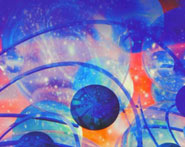


 الفيزياء الكلاسيكية
الفيزياء الكلاسيكية
 الكهربائية والمغناطيسية
الكهربائية والمغناطيسية
 علم البصريات
علم البصريات
 الفيزياء الحديثة
الفيزياء الحديثة
 النظرية النسبية
النظرية النسبية
 الفيزياء النووية
الفيزياء النووية
 فيزياء الحالة الصلبة
فيزياء الحالة الصلبة
 الليزر
الليزر
 علم الفلك
علم الفلك
 المجموعة الشمسية
المجموعة الشمسية
 الطاقة البديلة
الطاقة البديلة
 الفيزياء والعلوم الأخرى
الفيزياء والعلوم الأخرى
 مواضيع عامة في الفيزياء
مواضيع عامة في الفيزياء|
Read More
Date: 23-3-2016
Date: 8-1-2021
Date: 23-3-2016
|
Hubbel Space Telescope
An important limit to telescopes on earth, in their ability to distinguish fine detail, is turbulence in the atmosphere. Blobs of air above the telescope move around causing the star image to move, blurring the picture. This motion, on a time scale of about 1/60 second, is what causes stars to appear to twinkle. The effects of turbulance, and any distortion caused by the atmosphere, are eliminated by placing the telescope in orbit above the atmosphere. The largest telescope in orbit is the famous Hubble telescope with its 1.5 meter diameter mirror, seen in Figure (1). After initial problems with its optics were fixed, the Hubble telescope has produced fantastic images like that of the
Eagle nebula seen in Figure (2) reproduced here. With a modern telescope like the Keck (see next page), the effects of atmospheric turbulance can mostly be eliminated by having a computer can track the image of a bright star. The telescopes mirror is flexible enough that the shape of the mirror can then be be modified rapidly and by a tiny amount to keep the image steady.

Figure 1: The eagle nebula, birthplace of stars. This Hubble photograph, which apeared on the cover of Time magazine, is perhaps the most famous.

Figure 2.



|
|
|
|
التوتر والسرطان.. علماء يحذرون من "صلة خطيرة"
|
|
|
|
|
|
|
مرآة السيارة: مدى دقة عكسها للصورة الصحيحة
|
|
|
|
|
|
|
نحو شراكة وطنية متكاملة.. الأمين العام للعتبة الحسينية يبحث مع وكيل وزارة الخارجية آفاق التعاون المؤسسي
|
|
|